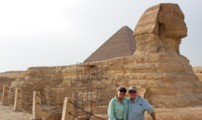Our cruise itinerary was rearranged to fit weather, tides, local politics, and committed ports for 930 guests tired of missed ports.
Cape Horn
Rising like a pillar above the point where the Atlantic and Pacific Oceans converge, Cape Horn is a rocky headland on Hornos Island in southern Chile’s Tierra del Fuego archipelago. The cliffs at Cape Horn are 1400 feet tall and the landscape is remote, stark and treeless. It is the continents southernmost point.
As we sailed around the Cape, we experienced the winds, the rain and the cold. Because of fog, we didn’t know if we’d be able to see anything so braving the wind, rain and cold was well worth it. As we stood on the Viking deck looking through our binoculars, poised with cameras, in our warm hats, boots, gloves, 10 layers of clothing, and being served hot chocolate by the staff, we were humbled to think about what life was like back in 1616 when the Cape was discovered.
We were also lucky to have Dr. Tony Waltham, a geologist with an incredible sense of humor and was actually on the inaugural voyage with us, narrating the sail.
As we rounded the point, we saw the albatross-shaped Cape Horn Monument which commemorates the lives of thousands of seafarers who perished attempting to sail around the Cape. It was built in 1992. Two lighthouses are also nearby; one is made of fiberglass and stands 13 feet tall while the second one is considered to be the “real” lighthouse and has a range of 30 miles. It sits near the water’s edge and is a beacon of assurance and safety for countless sailors since 1991. It is the world’s southernmost traditional-style lighthouse.
Sailing around Cape Horn has been compared to climbing Mount Everest and the claim is that fewer people have achieved the former than have climbed the latter since the initial summit of Mount Everest in 1953.
Beagle Channel
We spend the day sailing the Beagle Channel. It stretches 150 miles between the Atlantic and Pacific Oceans, and is a mere three miles wide at its narrowest point. To the north is the snowcapped Tierra del Fuego which lies between Chile and Argentina. To the south are countless small islands forming one of the most scenic archipelagos in the world. And of course, the blue glaciers spilling into the waters are everywhere.
We’ve been waiting all day for the Garibaldi Glacier to appear and there it is. It’s one of Chile’s most beautiful glaciers. This mammoth wall of sapphire and teal-colored ice doesn’t disappoint as it towers over us. It stands 8,786 feet high with an area of more than 114,829 feet. A notable feature of the Garibaldi Glacier is its medial moraine.
A moraine is erosional debris (sand, gravel and rock) that has been carried along by the glacier. It forms along the sides and bottom of the glacier as the ice flows down the valley. A moraine found in the middle of a glacier is a medial moraine and is formed when two glaciers meet and the debris on the edges of the adjacent valley sides join and are carried on top of the enlarged glacier.
Viking sent some of our staff out in a tender to capture one of the icebergs from Garibaldi. It was quite the process and thanks to good binoculars we were able to watch most of the show. After a bit of discussion about which iceberg should be selected, there was the problem of how to get it back to the ship. There’s no way this berg could be lifted onto the tender so they had to net it and then drag it along in the water back to our ship. As you can imagine, it was freezing on the water and staff was having a hard time netting the darn thing and a bigger problem trying to get it on board. Capture of the iceberg was videotaped and the next day the berg was on display, in all its glory, on the pool deck with the video playing. Our executive chef put on a wonderful brunch a week later and the iceberg was carved into a polar bear (yes, we have 2 chefs on board who are master ice carvers and have provided us with some amazing carvings).
We don’t know if all cruise ships go to this length; all we know is how grateful we are to Viking for providing us with an adventure never to be forgotten.
Chilean Fjords
This is a pristine paradise of soaring peaks, countless lush islands filled with wildlife and a tapestry of glaciers, waterfalls, icebergs and rivers. The fjords are one of the most rugged and untamed places on earth. The entire ship was glued to the viewing of untouched wilderness as Portuguese explorer Ferdinand Magellan and naturalist Charles Darwin saw it. We spend the entire day cruising by vast ice fields, glaciers flowing and some calving into the water’s edge from the Andean mountainsides and waterfalls careening down steep forested slopes. Unfortunately, today’s weather is not so good; fog and mist, but the narration was good until he gave up and just turned off the mic and left the bridge. It’s about the same time we are approaching Amalia, which is another glacier we’ve been waiting for. And, like a miracle, the fog clears just enough for us to see her. The captain sails by and then does a pirouette so the other side of the ship can see her. And just for good measure, and because it’s still clear, he does another one. It’s like we’re dancing in the fjords. And then the fog returns!
